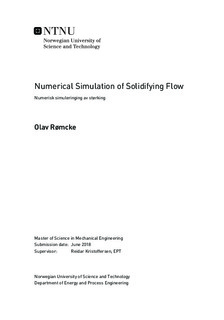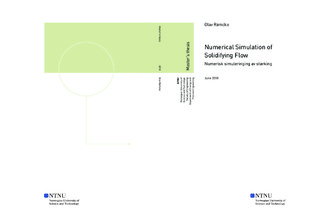| dc.description.abstract | This thesis consists of deriving and testing a numerical model for convection dominated solid-liquid phase transitions. Two scientific articles represents the main body of the thesis, but a short documentation of the work and code development in FORTRAN is also included. The abstracts of the two articles say:
Abstract, Article 1:
A simple model for solving convection/diffusion phase transition problems will be described. Pure substances are the focus of this paper, but extension to more complex temperature dependent phase transitioning behaviour is also addressed. This method utilizes a non-deforming, staggered, cartesian grid. A Boussinesq approximation is the driving force for the natural convection, while the Poisson pressure-correction equation is solved with a conjugate gradient method. A simple marking method for liquid and solid cells are updated at every time step, such that the pressure-correction only needs to be solved in the domain where the substance is liquid. Solving the thermal fields (i.e. solid fraction and temperature) utilizes a projection method derived in this paper.
A description of the Darcy source term for handling fluid flow in the solid region, as well as a Source-based method for solving the thermal fields are also presented, and compared to the method derived in this paper. Model validation is done by comparison with experimental results of a 2D cavity convection/diffusion case with gallium.
Abstract, Article 1:
A projection method for solving solid-liquid phase transitions is utilized for a 3D square cavity. This square cavity is compared to an experimental study of pure gallium. The difference between 3D and 2D results are also highlighted in this paper. In addition, a 2D study of the effects of the governing non-dimensional parameters and a demonstration of the importance of the convective currents are also done.
The first article deals primarily with model testing. For the 2D case, the model yielded good fit with experiments, and a significant difference in computational efficiency with respect to the compared models. This efficiency increase have been identified as the following: Firstly, the model derived here does not solve the Navier-Stokes equations in the regions where material is solid. Secondly, compared to the Source method for phase transitions only one calculation of the temperature field is needed at every time step.
The second article deals with extension to 3D and demonstrates different use of the model. Extensions to 3D was trivial, but simulations showed that a different flow pattern in the melt had a significant impact on the position of the solid liquid interphase. An attempt was made at finding a non-dimensional group who could correlate well with the overall liquid fraction. In addition, two mould melt systems were simulated in order to demonstrate how the convective currents can affect the evolution of the solid-liquid interphase during a casting scenario.
The final part of the thesis aims at presenting the work that was not presented in the two articles. This include how boundary values and discretization schemes was defined, as well as preliminary testing of the fluid and thermal models. The model was numerically capable of handling discontinuities in the solid fraction-temperature relation (i.e. linear-eutectic transition) as well as transitioning several nodes from fully liquid to fully solid in one discrete time step. | |

